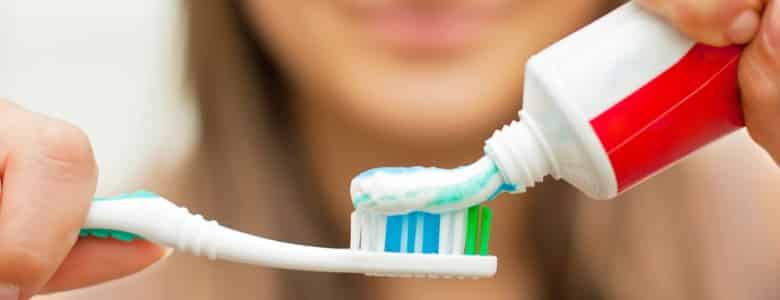We all know that it’s important to exercise important healthy oral hygiene and brush our teeth at least twice a day in order to prevent tooth decay, however choosing the right toothpaste can be a daunting exercise considering the sheer number and variety of toothpastes on offer.
Whitening, tartar control, anti-plaque and desensitising toothpastes – the options are endless, and then there’s the additional stress of choosing the right toothpaste for your toddler, whose baby teeth are just starting to come through. But the expert team here at Australia Dental are here to help. Here’s our guide on how to choose the right toothpaste.
Fluoride In Toothpaste Helps Strengthen Tooth Enamel
Regardless of the type you prefer using, the single most important ingredient in toothpaste is fluoride. Fluoride is a mineral that occurs naturally in water and in many foods, and it assists with re-mineralising, which helps to strengthen the enamel on your teeth.
This makes your teeth more resistant to acid attacks from bacteria and sugars in the mouth and has been proven to reverse early decay, particularly if you choose the right toothpaste and brush with it regularly.
Abrasives In Toothpaste Help Polish Your Teeth
Abrasives in toothpaste actually polish teeth and help remove stains and stubborn particles of food, however thankfully the quantity is not enough to scratch or damage your tooth enamel! And although they play an active role in toothpastes, abrasives are technically considered ‘inactive’ because they don’t actually play a role in reducing your risk of cavities or gum disease.
Examples of abrasives include calcium carbonate, dehydrated silica gels and hydrated aluminium oxides, and when choosing the best toothpaste, you should check for their inclusion in the ingredients list on your toothpaste’s packaging.
Sensitive Teeth May Need A Specialised Toothpaste
If you suffer from teeth that are sensitive to hot or cold, the flash of pain that you feel is caused by dentin (which is the bone at the core of your teeth) being exposed, which then allows heat and cold to increasingly impact your sensitive tooth nerves.
When buying toothpaste for sensitive teeth, there is an array of choices, however, ingredients are generally broken into two categories. Those that include potassium nitrate and potassium citrate, which work by stopping the nerves from transmitting signals, and those that contain ingredients like strontium, arginine and calcium sodium phosphosilicate, which work by blocking your dentine tubules (the ‘pores’ in the roots of your teeth). But regardless of your choice, try to choose one that also contains fluoride so that you’re gaining additional benefits as well.
Whitening Toothpaste Can Help Remove Stains
Popular with people who frequently drink tea, coffee, wine and other staining liquids, whitening toothpastes contain substances that bind to stains and are gently abrasive. This combination helps them stick to the stains on teeth and lift them away without causing harm to the enamel.
Abrasive ingredients can include phosphates, carbonates, silica compounds or aluminium compounds, and although they generally remove surface stains, they don’t actually lighten the colour of your teeth.
The downside of using whitening toothpaste is that it can cause irritation and gum inflammation and eventually lead to gum and tissue recession.
Tartar Control Toothpaste Prevents Tartar Build Up
Another option in our toothpaste buying guide is tartar control toothpaste which contains ingredients that may be effective in breaking down plaque on your teeth before it hardens into even-harder-to-remove plaque. These toothpastes, however, are intended to prevent tartar forming rather than removing it, and often do little to prevent tartar build up below the gum line.
Anti-Plaque Toothpaste May Help Prevent Gum Disease
When choosing the right toothpaste, an anti-plaque variety may be of use if you’re looking to inhibit the build-up of plaque. These toothpastes work to reduce the effect of bacterial toxins on the tissues that surround your teeth and may reduce the chance of you getting gum disease in the future.
Young Children’s Toothpaste Needs Are Different to Adults!
It’s never too early to start an oral health routine, so as soon as you see your child’s ‘baby’ teeth breaking through their gum line, it’s time to start brushing your child’s teeth.
Most ‘children’s toothpastes’ are specifically designed for children aged two and older, and these generally contain less fluoride as most children don’t effectively spit toothpaste out when brushing. Too much fluoride increases the risk of fluorosis (which is a mottling of the enamel), which is why most dentists recommend that only children over the age of six use regular strength toothpastes.
When choosing the right toothpaste for your child, it’s also worth looking for the Australian Dental Association seal of approval and avoiding toothpastes that contain harsh abrasives that can damage young tooth enamel.
And if actually getting your child to brush their teeth is an issue, consider the flavour. Many children often find traditional flavours like mint to be too ‘spicy’ so child-friendly options can often work.
Still confused about what toothpaste your family should be using? The friendly staff at Australia Dental can help! Contact us on (07) 3888 9125 or (07) 3284 7112.


